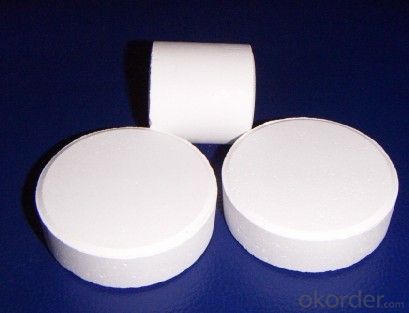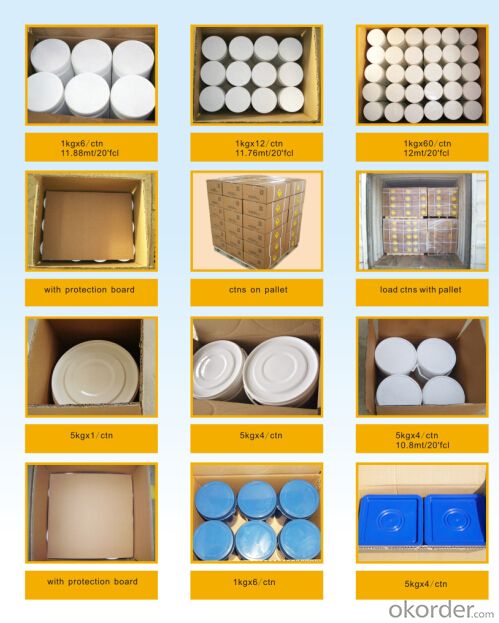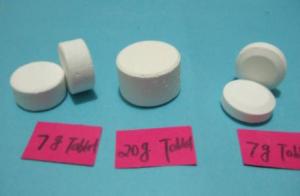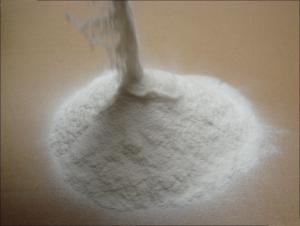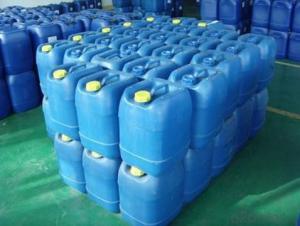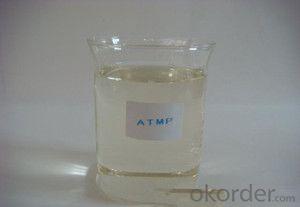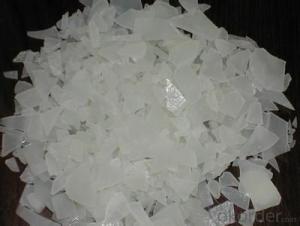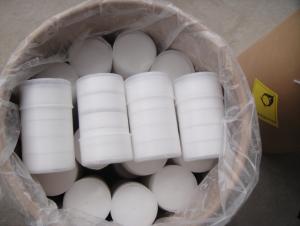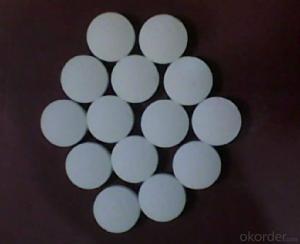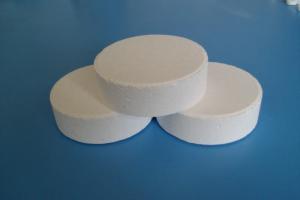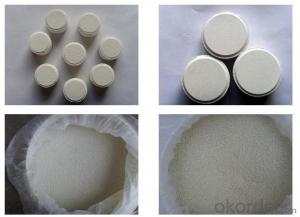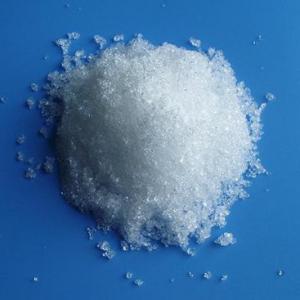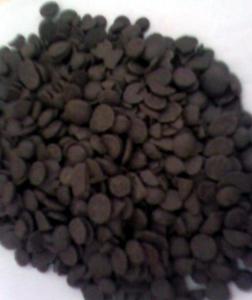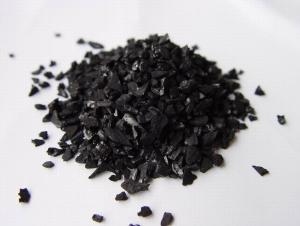TCCA Chlorine Tablet/Powder/Granular For Water Treatment Chemical
- Loading Port:
- Tianjin
- Payment Terms:
- TT OR LC
- Min Order Qty:
- 22 m.t
- Supply Capability:
- 8000 m.t/month
OKorder Service Pledge
OKorder Financial Service
You Might Also Like
TCCA 90% Powder, Granular, Tablets
Introduction:
TCCA White tablet with irritant chlorine odor. Slight solute in water. TCCA is the organic compound with the formula (C3Cl3N3O3). It is used as an
industrial disinfectant, bleaching agent and a reagent in organic synthesis.
This white crystalline powder, which has a strong "chlorine odour," is sometimes sold in tablet or granule form for domestic and industrial.
Specification:
Chemical Name | Trichloroisocyanuric Acid |
Molecular Formula | CONCL3 |
CAS Number | 87-90-1 |
Avaliable Chlorine %min | 90.00 |
Moisture content %,wt,Max | 0.30 |
PH Value (1% solution) | 2.7~3.3 |
Solubility 25℃ Water | 1.2g/100g |
Solubility 30℃ Acetone | 36g/100g |
Specific Gravity | 0.95(light)/1.20 |
Granular Particles Size
Mesh | 5~8 | 8~30 | 20~40 | 20~60 |
Tablets Forms
Weight | 200 gram | 150gram | 100gram | 50gram | 30gram | 20gram | 15gram | 10gram |
Diameter(mm) | 76 | 70 | 50 | 42 | 30 | 30 | 30 | 30 |
Height(mm) | 25 | 21 | 26 | 27 | 22 | 16 | 12 | 8 |
Multi-Functions
We made multifunctional tablets according to customers’ needs. For Instance, we press TCCA 90% granular with chemicals such as Boric Acid,. Sulfate Copper, Sulfate Aluminum And PAC.
Packing:
Granular& Powder:
50KG PLASTIC DRUMS/ FIBER DRUMS.25KG PLASTIC DRUMS/FIBER DRUMS.1000KG BIG BAGS.Or any other packages suggest by customers.
Tablets:
Inner Packing:
Individually Wrapped for 200gram,150gram, 100gram,1kg Plastic tube for 200gram,1kg plastic bottle & 5kg plastic bottle for smaller tablets
Outer Packing:
50KG,25KG,10KG, 5KG plastic Drums. Or any other package specified by customers, such as fiber drums or cantons.
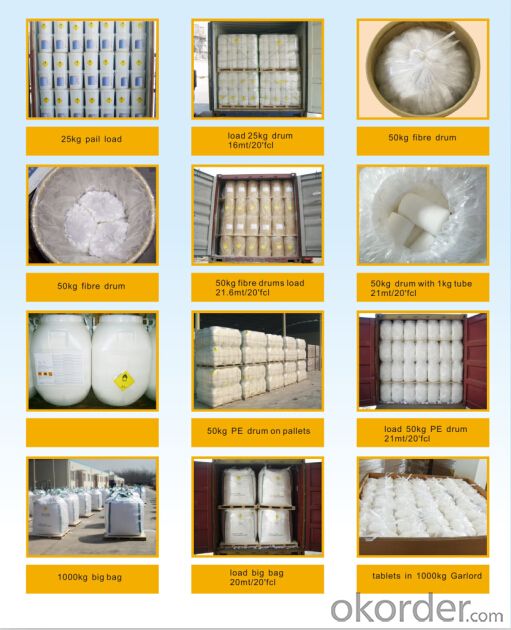
Delivery Port
Tianjin Port
Payment terms :
T/T,L/C at sight
Storage :
Shall be sealed and stored in the dry and ventilated place to prevent from rain ,high temperature and strong sunlight .
Sample management
Free sample to be offered before place an order.
1.What's the packing of chlorine dioxide tablet in your company ?
Adopt PE drum or iron drum, or according to customer's requirement .
2.What is the chlorine dioxide tablet of your company?
The MOQ of the chlorine dioxide is 5 metric ton.
3.What about the quality ?
Please rest assure the quality ,for the quality control ,the manufacturer follow the scientific managing system and measurement method with serial high-tech test equipments.
- Q: Name one case in which catalyst poisoning is useful?
- Usually, catalyst poisoning is undesirable as it leads to a loss of usefulness of expensive noble metals or their complexes. However, poisoning of catalysts can be used to improve selectivities of reactions. In the classical Rosenmund reduction of acyl chlorides to aldehydes, the palladium catalyst (over barium sulfate or calcium carbonate) is poisoned by the addition of sulfur or quinoline. This system reduces triple bonds faster than double bonds allowing for an especially selective reduction. Lindlar's catalyst is another example — palladium poisoned with lead salts. As described by its inventor,[1][2] the catalyst is prepared by reduction of palladium chloride in a slurry of calcium carbonate followed by adding lead acetate. By this approach, one obtains a catalyst with a large surface area. Further deactivation of the catalyst with quinoline enhances its selectivity, preventing formation of alkanes. An example of alkyne reduction is the reduction of phenylacetylene to styrene.[1] en.wikipedia.org/wiki/Lindlar%27s...
- Q: Cl + O3 ---> ClO + O2O + ClO ---> Cl + O2= O + O3 ----> 2O2What is the catalyst? The intermediate?How do you know which is which? If the rate law is rate=k [O3] [Cl]determine:a) the overall order.b) unit for k.c) the rate determining step, justify your answer.
- Cl is the catalyst. ClO the intermediate. The catalyst is the component which does not change in overall reaction. He forms some intermediate component(s) with the reactants. In the later reaction steps the intermediate(s) react forming the catalyst in its original state. (a) The overall order is the sum of the orders with respect to the components: n = 1 +1 = 2 (b) the unit of the rate of reaction is r [=] mol/ (Ls) (more general mol per unit time and volume) compare dimensions mol / (Ls) [=] k · mo/L · mol/L =k [=] L/(s mol) (more general unit volume per unit time and mole) (c) First reaction For elementary reaction steps the order of the reaction rate with respect to a reactant is equal to stoichiometric coefficient. Hence the rate of first reaction is: r? = k?·[Cl]·[O?] Overall rate is given by the rate determining step, while other reaction steps are in equilibrium: r = r? = k?·[Cl]·[O?] If second reaction is the rate determine step r? = k?·[O]·[ClO] while reaction 1 is at equilibrium K? = ( [ClO]·[O?] ) / ( [Cl]·[O?] ) =[ClO] = K?·( [Cl]·[O?] ) / [O?] the overall rate would be: r = r? = k?·[O]·[ClO] = K?·k?·[O]·[Cl]·[O?] / [O?] = k·[O]·[Cl]·[O?] / [O?] That doesn't match the observed rate law
- Q: Please help me
- catalyst are enzymes that increase the rate of a reaction. they both are proteins. so basically, a catalyst is an enzyme that increases the rate of a reaction.
- Q: Junior high school chemistry - chemical reaction before and after the quality and chemical properties of the material must be the catalyst?
- It is not always possible that the equivalent reaction, i.e. one or more of the reactants, is the same as the relative atomic mass of one or more of the products and the coefficients in the chemical equation are the same
- Q: Horseradish enzyme catalyzed Luminol chemiluminescence reaction
- Disinfectant ah ~ bleach ah ~ ~ take this kind of thing to wash the blood once something can interfere with Lumino identification. So that want to do bad things must be a good plan. Lumino in the presence of copper, copper alloy, horseradish or some bleach in the presence of fluorescence. So if the scene of the crime was bleached
- Q: What is the difference between an enzyme catalyst in a living body and a catalyst in chemistry?
- The enzyme has a high degree of specificity
- Q: Hydrogen and nitrogen in the high temperature and pressure and catalyst conditions for the synthesis of ammonia chemical equation
- 3H2 + N2 = 2NH3 conditional catalyst
- Q: What are the catalysts?
- Some chemical reactions are not only the only catalyst, such as potassium chlorate can be thermally decomposed to catalyze the presence of magnesium oxide, iron oxide and copper oxide, etc. The definition of the chemical reaction can change the chemical reaction rate of other substances in the chemical reaction , And its own quality and chemical properties before and after the reaction did not change the material called catalyst, also known as catalyst. Catalyst in the role of chemical reaction called catalysis
- Q: Chemical reaction plus catalyst on the △ H no effect
- Since the addition of the catalyst only accelerates the reaction process and does not have an effect on the reaction product and the reactants
- Q: chemistry subject
- A catalyst is a substance which alters the rate of a chemical reaction but is chemically unchanged at the end of the reaction there are well some of em are 2,2'-Bis(2-indenyl) biphenyl Adams' catalyst Band 3 Cerium(IV) oxide Copper(II) acetate Copper(II) hydroxide Cyclooctadiene rhodium chloride dimer 4-Dimethylaminopyridine Enzyme engineering Faujasite Frustrated Lewis pair Grubbs' catalyst Hopcalite Incipient Wetness Impregnation Lanthanide triflates Lindlar catalyst Mesoporous silicates Methylaluminoxane NOBIN Nickel(III) oxide Noxer block Palladium on carbon Phase transfer catalyst Platinum Polyoxometalate P cont. Post-metallocene catalyst 2-Pyridone Pyrotol catalyst Raney nickel Ribozyme Tetrakis(triphenylphosphine)palladium(... Tetrakis(triphenylphosphine)platinum(0... Triazabicyclodecene Tris(dibenzylideneacetone)dipalladium(... Trost ligand Vanadium(V) oxide Wilkinson's catalyst Ziegler-Natta catalyst
Send your message to us
TCCA Chlorine Tablet/Powder/Granular For Water Treatment Chemical
- Loading Port:
- Tianjin
- Payment Terms:
- TT OR LC
- Min Order Qty:
- 22 m.t
- Supply Capability:
- 8000 m.t/month
OKorder Service Pledge
OKorder Financial Service
Similar products
Hot products
Hot Searches






